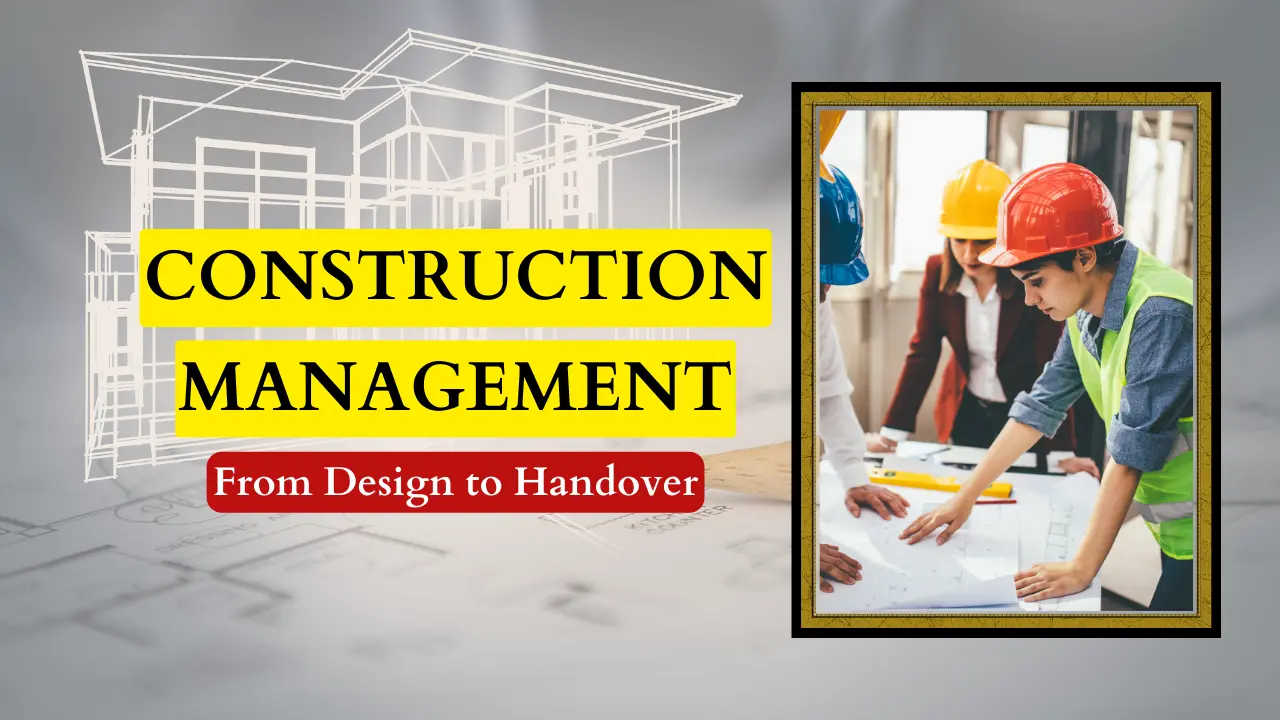
Building Success: The Business Impact of Efficient Construction Management from Design to Handover
Are you a construction professional, business owner, or someone just curious about what makes a construction project truly successful? If yes, you must know the secret key behind the success, known as efficient construction management.
It mainly focuses on project quality, time, safety, and cost. An efficient construction management ensures that various resources in the construction process, such as labor, materials, and machinery, are utilized effectively to complete the project with optimal cost, quality, and time.
It also helps ensure the overall safety of the people working and visiting the construction site. This is absolutely important to make the client happy while saving project costs, human lives, and enhancing the quality of the building project.
Key Takeaways
- Understand the importance of efficient construction management in ensuring project success by focusing on quality, project time, safety, and cost.
- Learn how effective resource utilization, including labor, materials, and machinery, optimizes project outcomes.
- Explore the impact of the construction process on business, covering crucial stages like design, planning, building, MEP installation, and commissioning.
- Discover the role of technology and collaborative design processes in improving construction efficiency and quality.
- Recognize the significance of sustainable practices, risk management, and the delivery of complete, functional projects for long-term success and client satisfaction.
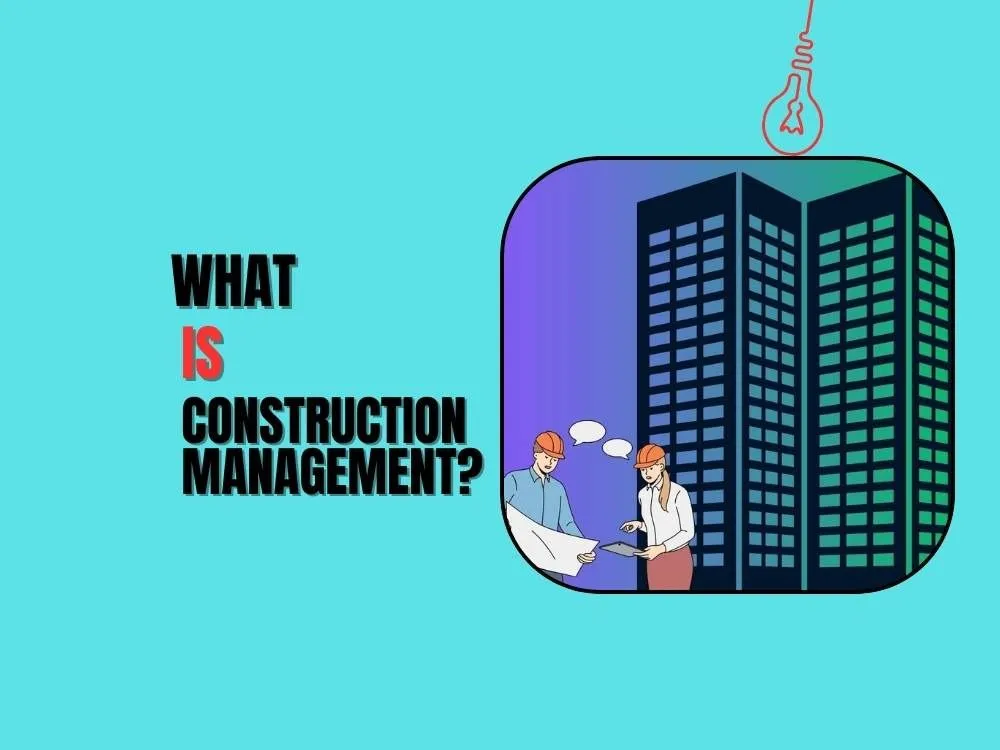
Construction Process and Its Impact on Business
The construction process involves different stages from design to handover. It significantly impacts businesses in different ways. Here’s how:
1. Design Stage
An architect or a design professional is generally responsible for designing a building project based on the client's requirements. The design is a prominent aspect that directly influences how a building is gonna to be constructed. Plus, the overall cost of the project is determined based on the building design.
The energy-saving ideas are properly planned in the design phase of the construction. It's called a passive energy-saving mechanism that includes:
- Correct building orientation for natural lighting.
- Proper material selection for longevity and less cooling load requirements.
- Proper selection of lighting fixtures to save energy.
- Sustainability set-ups like green energy initiatives are in the construction design. For example, Solar panels on the rooftop can harvest natural energy.
2. Project Planning Stage
This stage of the construction process involves planning every important factor to complete the project with the best quality, optimum cost, and on time. Project managers are responsible for planning the project.
They ensure proper procurement of construction materials, efficient labor utilization, vendor management, and other vital factors to complete the project as per the business’s (client’s) requirements. It directly impacts the business, where inefficient project planning may lead to project delays, dilapidation, wastages, and other costly impacts.
3. Construction Stage
At this stage, civil or structural engineers and their subordinates construct the building while considering important factors such as load-bearing capacity, weather conditions, the ability to withstand natural disasters, and functionality.
These factors are important to the business for continuous operation. Plus, properly establishing these factors in the construction phase helps reduce downtime and losses by ensuring the proper functionality.
4. MEP Installation Stage
Once the construction of the building is over, it has to be equipped with the necessary mechanical, electrical, and plumbing (MEP) services to facilitate the functionality of the building. MEP engineers or managers have the responsibility to install all necessary MEP services such as HVAC, electrical distribution, water supply, sewage, access control, vertical transportation (Elevators and Escalators), PABS, and other vital systems.
This installation should be carefully done by expert professionals to improve business functionality and reduce risk and operating costs. By selecting energy-saving equipment in the MEP installation phase, organizations can reduce significant energy expenses once they begin operations. (Example: Inverter-type AC).
5. Commissioning and Handover Stage
Commissioning is one of the most important stages of the construction process that impacts business organizations. Before handing over the completed building and billing the client, it's crucial to check the functionality of all building elements. It's inevitable to primarily check whether every system and element works properly without any issues.
Commissioning engineers and experts thoroughly check every system of the building and report a comprehensive document to the building owner. This ensures a proper handover of the building project by ensuring everything is up to a standard functionality level.
The Role of Design in Efficient Construction Management
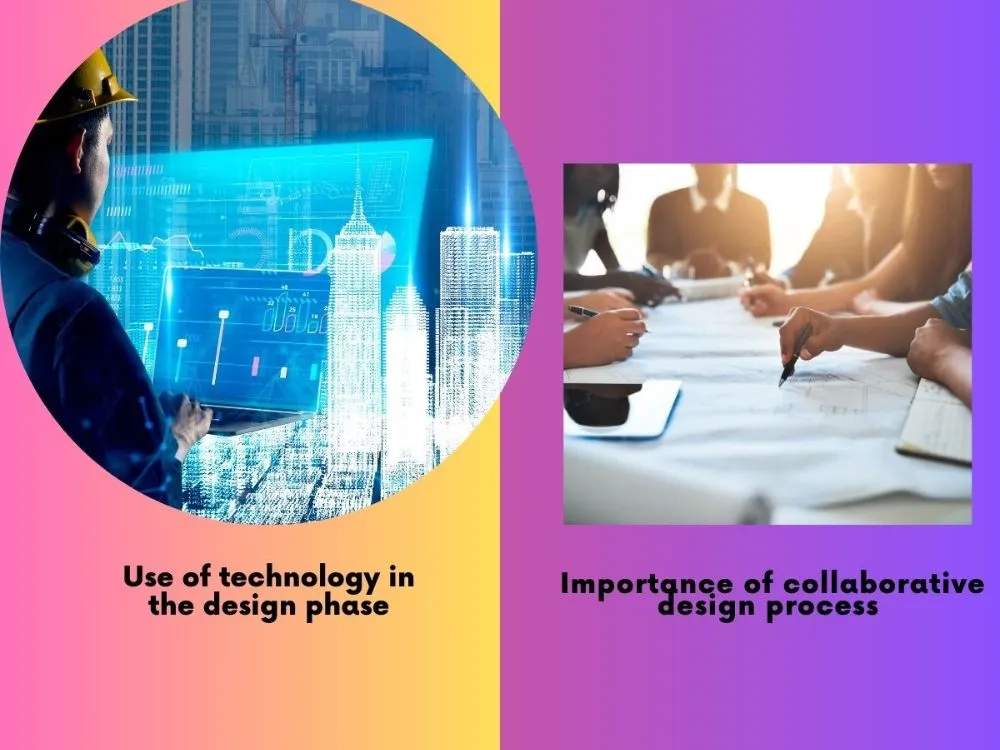
Importance of Collaborative Design Process
The project may involve many stakeholders who present their design concepts. Implementing the best design for the project is only possible through a collaborative design process. It's crucial to get different suggestions from important stakeholders such as clients, contractors, engineers, and architects.
This helps create the best design with the focus of improving the overall functionality of the project. Moreover, this process presents innovative ideas in the design process to improve quality and reduce time and budget.
Use of Technology in The Design Phase (BIM, 3D Modeling)
Using advanced technology in the design phase helps create an elegant design that fulfills all relevant aspects of the building project. Building information modeling (BIM) and 3D modeling are efficient technology tools for creating such designs. They ease the process with accurate results.
Building Information Modeling (BIM) facilitates collaborative design, while 3D modeling enables designers to visualize construction projects realistically. These technologies are crucial in enhancing design efficiency, which results in optimal project outcomes. Moreover, if you have a good design image, you can get similar images on search engines by using our reverse image search tool.
Importance of Effective Project Planning
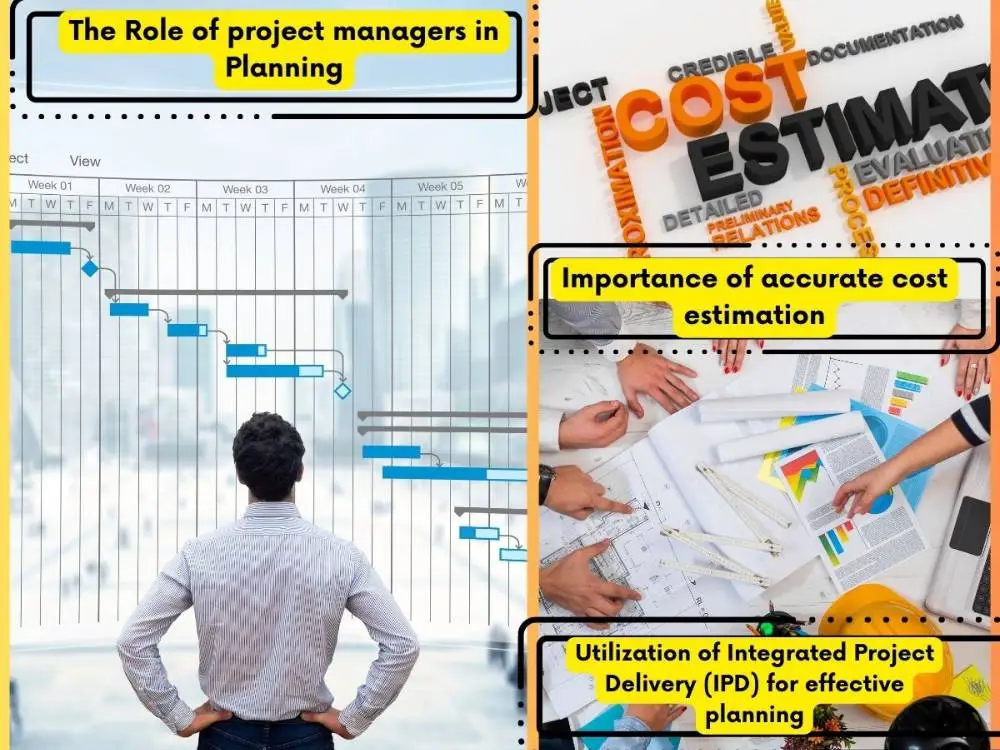
The Role of Project Managers in Planning
The role of project managers in constructing a building is inevitable from the project initiation to the handover. Project managers take responsibility for the entire project to make it successful. In the planning stage, project managers play a very crucial role in planning key objectives, resource requirements, completion timeframe, budget, quality, and all necessary factors of the project.
Also, project managers develop a complete plan by networking with other stakeholders. They make sure everything goes well with the plan. Their involvement in the planning stage ensures successful project completion by lowering costs and enhancing quality.
Importance of Accurate Cost Estimation
In the project planning process, accurate cost estimation is crucial. It showcases how much financial resources are required to complete the project. This provides a clear idea of the budget requirement to the client.
If the cost estimation has major drawbacks like an overvalued budget, the client finds that suspicious and refrains from allocating enough financial resources to the project. This can cause project delays.
Further, an accurate cost estimation and calculation of the project help make informed decisions regarding financial risks, uncertainties, and ROI that can increase the project's feasibility.
Utilization of Integrated Project Delivery (IPD) for Effective Planning
Integrated project delivery (IPD) has a significant impact on effective project planning by involving all necessary stakeholders in various phases of the design and construction. It creates value in the project by getting multiple innovative ideas from owners, designers, builders, and other relevant parties.
It's helpful to mitigate potential risks, allocate resources effectively, reduce disputes, and increase project efficiency. It's vital to utilize IPD in the project planning process to obtain the advantages that are possible.
Building for Sustainability
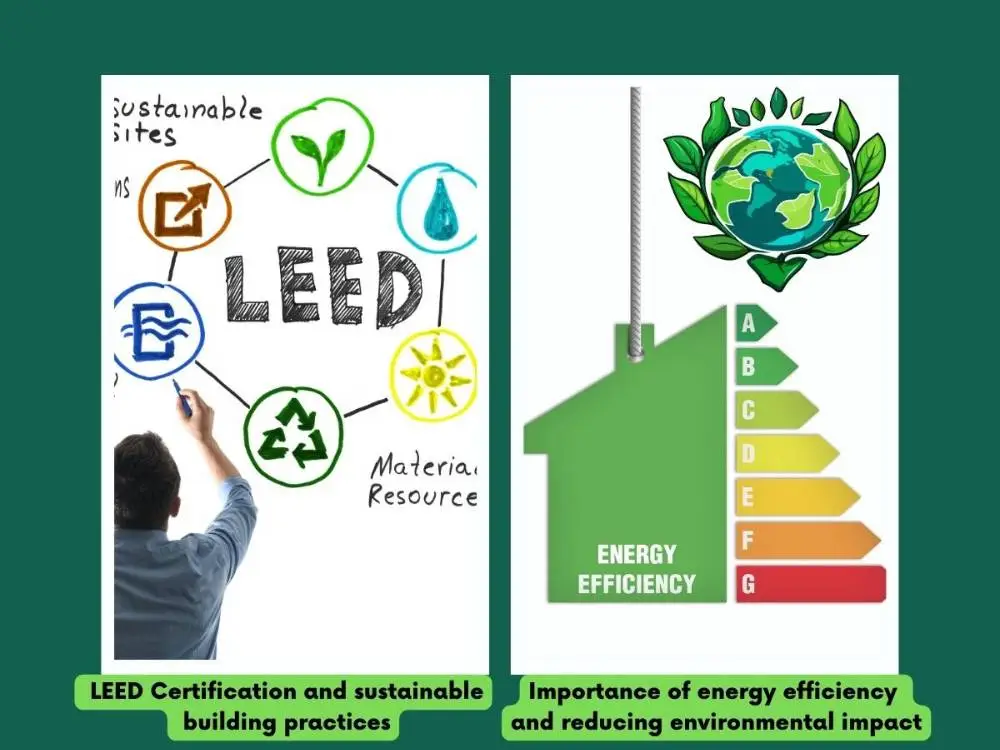
Overview of LEED Certification and Sustainable Building Practices
Sustainable building practices are in increasing demand nowadays. LEED certification is a renowned rating system for building energy and environmental considerations. It motivates sustainable practices in the building project, such as energy conservation, utilization of sustainable materials, and improving indoor air quality.
By getting LEED certification, businesses can make sure that their construction project is adapting to sustainable practices. This helps enhance the overall reputation of the business.
Importance of Energy Efficiency and Reducing Environmental Impact
Energy efficiency is important to cut down on unnecessary costs. Businesses perceive its importance in the early stage of the construction process and make necessary arrangements in their design, procurement, and other important steps.
Reducing the environmental impacts is another vital feature. Adverse impacts on the environment from constructing a building are not desirable and cause many disadvantages.
Therefore, organizations should implement proper measures to reduce environmental impacts while doing a construction project. They need to select machinery and materials that are energy efficient.
Health and Safety in Construction
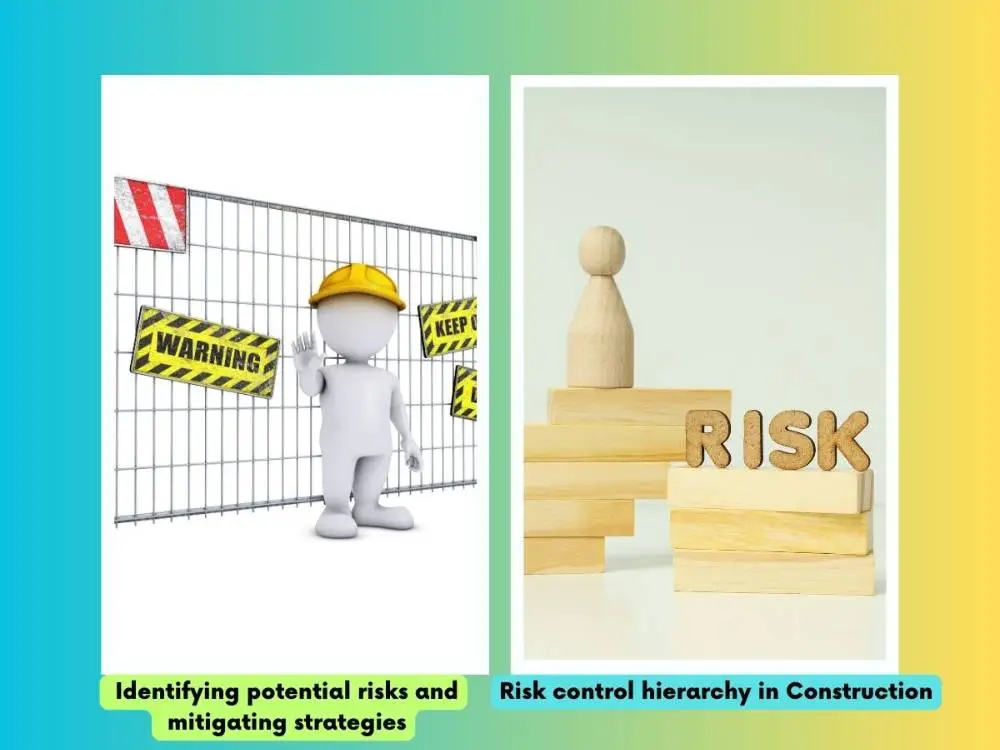
Identifying Potential Risks and Mitigating Strategies
The construction process involves a huge risk potential. So, several types of health and safety risks are possible to occur on the construction site, such as:
- Falling Objects
- Manual Handling
- Electrocution
- Vibration
- Noise
- Accidents
- Chemical Exposure
- Fire
- Tripping and Falling, Etc.
These risks are undesirable, and organizations should have proper mitigation strategies to eliminate their presence. There is a sequence of control strategies applicable to mitigate the risks, such as:
- Elimination
- Substitution
- Engineering Control
- Administrative Control
- The Use of Personal Protective Equipment (PPC)
Risk Control Hierarchy in Construction
Controlling potential risks in the construction project is vital to safeguarding construction workers, site visitors, and other people. The risk control hierarchy involves steps to control risks as below:
- Eliminating Risk: Risk elimination is a way to physically remove the presence of any hazard. Risk elimination is not always possible where removing the potential hazard is impossible. For example, stopping vehicle access to the premises to avoid accidents or switching paths. It can remove the hazard, but it's impossible to eliminate the necessary service.
- Risk Substitution: Using an alternative way to perform the work with less or no hazard is known as substitution. For example, using less hazardous chemicals or harmless solvents in the construction process is more effective in controlling risks than using harmful chemicals.
- Engineering Control: Utilizing engineering methods to safeguard machinery and reduce risk exposure is known as engineering control. For example, using machine guards for the cutting or welding machinery and installing soundproofing for the noisy equipment are some engineering controls to mitigate risks.
- Administrative Control: When all other control methods aren't possible to mitigate the risk, then administrative control can be efficient. It changes the way of working with safety concerns. Providing training, instructions, signboards, and other necessary things to the workers helps them gain awareness and follow safe work practices.
- PPE: Personal protective equipment is the final control method, where providing relevant PPEs to the workers is crucial to mitigate risk exposures. Safety helmets, goggles, boots, respiratory protectors, gloves, safety ropes to work at height, and other important PPEs are necessary to be provided by the employer.
Efficient Construction Processes and Their Impact on Business
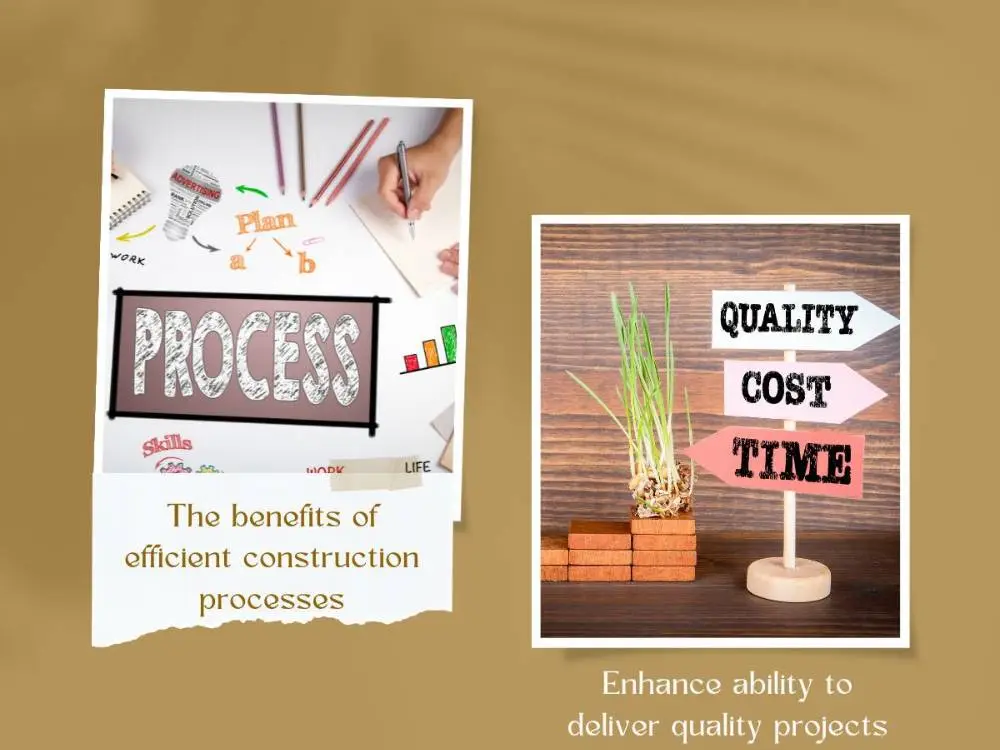
The Benefits of Efficient Construction Processes
An efficient construction process benefits the business in multiple ways. It can reduce costs by eliminating wastage and allocating resources with a cost-optimization strategy.
Also, the project can be completed on time without delays, and the business can start its operation on the expected time. If the construction process is inefficient, then there can be more delays and financial losses.
Moreover, an efficient construction process reduces potential risks and their consequences. This will lead to a safer workplace and enhance business reputation.
Enhance Ability to Deliver Quality Projects
Clients require a quality outcome, and an efficient construction process ensures the expected result is provided to the client. It optimizes every crucial feature in the construction process and enhances the overall quality. Features like proper material selection, human resources, design, fixtures, and other factors guarantee the quality of the project. This assures client satisfaction.
Moreover, a quality project outcome impacts the business positively by improving functionality, attracting more customers, and growing sales and profitability. The contractor gets more business from the same or different clients when they deliver quality projects through an efficient construction process.
Handover and Post-Construction Management
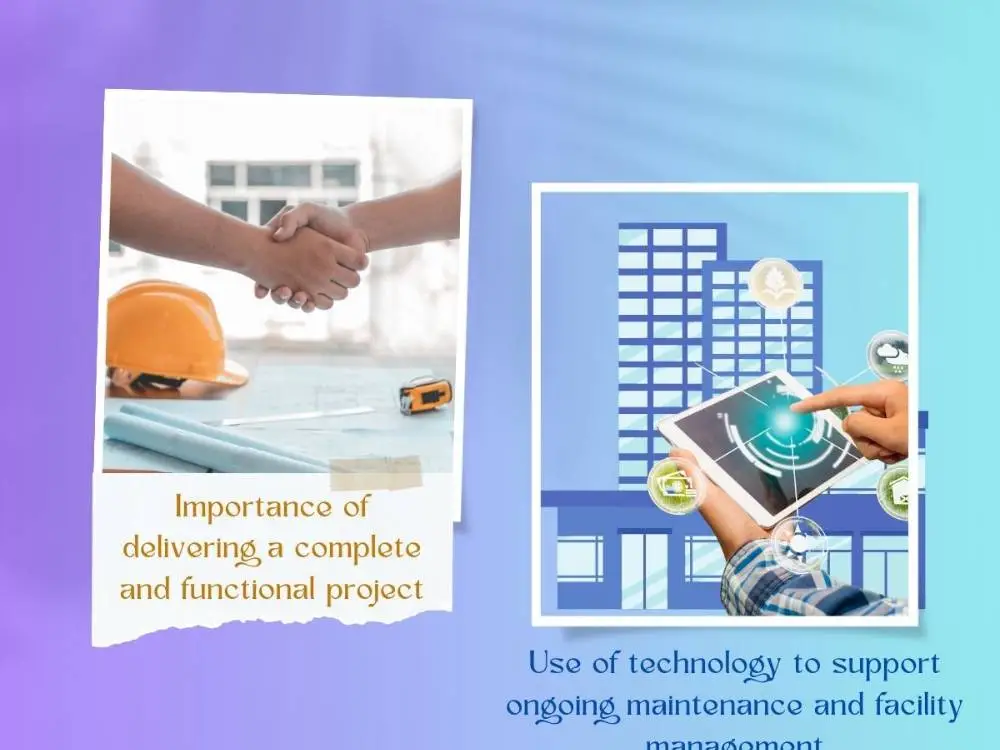
Importance of Delivering a Complete and Functional Project
Delivering a complete and functional project to the client is one of the most significant things in post-construction management. It's the contractor's responsibility to hand over the project with all features and functions relevant to the client’s expectations.
Commissioning is another important thing before handing over the project, which ensures all building systems are functioning as per the standard. A complete and functional project helps owners immediately start the business operation and ease maintenance.
Use of Technology to Support Ongoing Maintenance and Facility Management
Once the project is handed over to the client, the building facility should be maintained properly to ensure continuous operation without any chances for major breakdowns.
Maintenance and facility management are crucial in preserving the building. Many technology tools support these functions. Technology tools like CMMS, BMS, and IoT are efficient in performing all necessary maintenance for different systems of the building.
It also reduces costly repairs or maintenance of equipment. Plus, it saves huge energy costs through automation and efficient maintenance procedures.
Final Thoughts
Efficient construction management is crucial for the success of building projects. It encompasses various objectives like maintaining quality, time, safety, and cost. Construction involves many stages from the design phase to the handover phase. It begins with a collaborative design process that helps create an elegant design.
Effective project planning, accurate cost estimation, and integrated project delivery (IPD) can additionally contribute to successful project outcomes. Opting for sustainable practices in construction projects is another crucial thing to enhance the benefits of the project while considering health and safety, and delivering complete, functional projects to the client.
FAQs
Q1: What are the basic functions of construction management?
The basic functions of construction management consist of project planning, resource allocation, risk management, quality control, and ensuring on-time and cost-effective construction project completion.
Q2: What is the importance of construction?
Construction is crucial for creating infrastructure, buildings, and facilities that can support various aspects of society. Efficient construction ensures safe, functional, and sustainable structures, which contribute to overall societal development.
Q3: Why is risk identification and mitigation crucial in construction?
Identifying and mitigating risks in construction is vital to ensure the safety of workers and the success of the project. Effective risk management strategies, including the risk control hierarchy, help eliminate or reduce potential hazards.
Q4: How does efficient construction management contribute to sustainability?
Efficient construction processes contribute to sustainability by reducing waste, optimizing resource use, and incorporating sustainable practices. This benefits businesses by enhancing their environmental reputation and reducing long-term operational costs.
Q5: What is the significance of delivering a complete and functional project in post-construction management?
Delivering a complete and functional project is crucial for post-construction management as it ensures immediate business operations, eases maintenance, and enhances the overall satisfaction of the client. Proper commissioning is key to this process.
Explore Related Posts
https://smarttoolsai.com/post/length-converter-in-apparel-construction-and-other-key-industries
https://smarttoolsai.com/post/warehouse-logistics-area-converter
.webp)